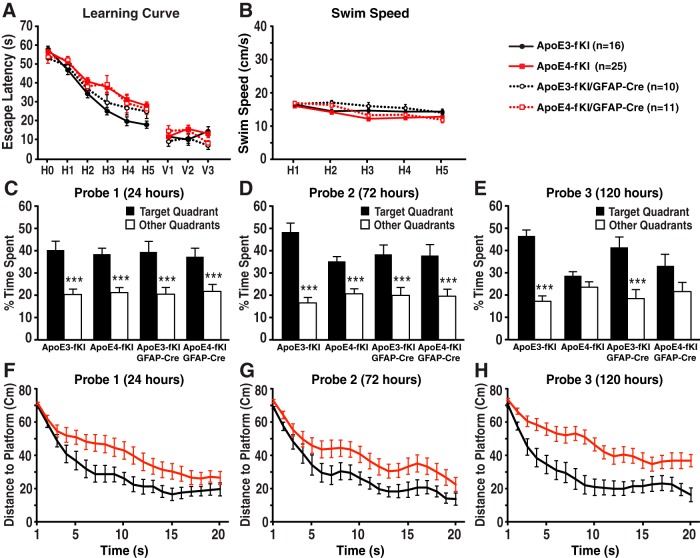Figure 2.
Deletion of apoE4 in astrocytes did not prevent the development of spatial learning and memory deficits in aged mice. A, Seventeen-month-old female apoE3-fKI, apoE4-fKI, apoE3-fKI/GFAP-Cre, and apoE4-fKI/GFAP-Cre mice were tested in the MWM. Points represent averages of daily trials. H, hidden platform day (2 trials per session, 2 sessions per day); H0, first trial on H1; V, visible platform day (1 trial per platform location, 3 sessions per day). Escape latency (y-axis) indicates time to reach the target. On the hidden platform days, latencies were analyzed and compared by repeated-measures ANOVA and Bonferroni post hoc test. ApoE4-fKI mice learned more slowly than apoE3-fKI mice (p < 0.01). ApoE4-fKI/GFAP-Cre mice learned significantly slower than apoE3-fKI mice (p < 0.05). There was no significant difference between apoE4-fKI and apoE4-fKI/GFAP-Cre mice. B, Swim speed was similar among the four groups of mice. C–E, Probe 1, 2, and 3 trials were performed 24, 72, and 120 h, respectively, after the last day of hidden platform training. Percentage time spent in the target quadrant versus the average percentage time spent in the other three quadrants was compared for each group of mice; ***p < 0.001 (one-way ANOVA and Bonferroni post hoc test). F–H, Average distance to target platform (in centimeters) for the first 20 s of probe trials 1 (F), 2 (G), and 3 (H). (Repeated measures two-way ANOVA, apoE3-fKI vs apoE4-fKI: probe 1, p < 0.05; probe 2, p < 0.05; probe 3, p < 0.001.)

